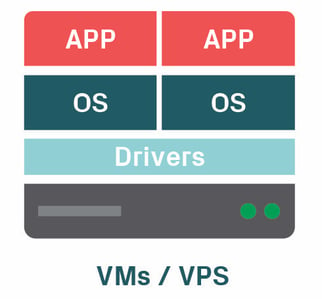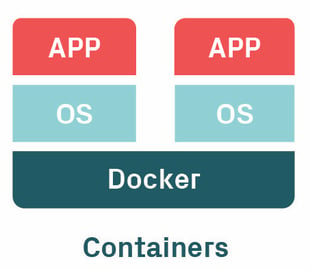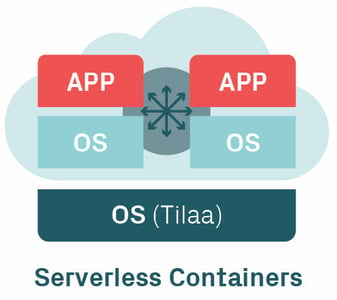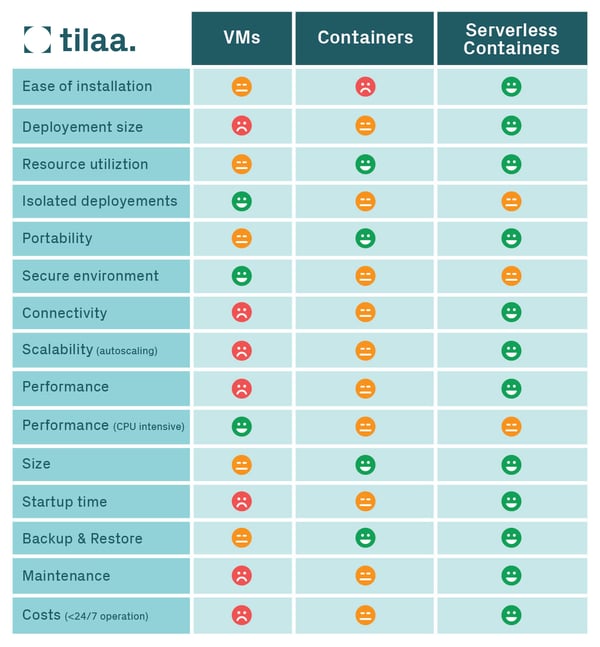
Managing your own IT infrastructure can be a real challenge. If you’re spending a lot of time, money and effort on trying to allocate and manage your computer systems, then Cloud VPS (VMs), Containers or Serverless Computing could be ideal.

Historically, the flexibility of computer applications has been restricted because they are bound to the server or operating system (OS) that executes their code. VMs, Containers and Serverless Computing solutions give DevOps teams the ability to deploy applications faster and more cost effectively.
However, while you can expect greater app development flexibility, VMs, Containers and Serverless Computing do present new management challenges for your IT team.
The question is, which one is the right fit for your system architecture and will give you the best value? See comparison model here.
What are VMs / VPSs?
VMs are Virtual Machines that can execute programs and applications like a computer, without the need for hardware. A VM is a computer file, often called an image, which emulates a computer. In other words a VM is a computer within a computer.

How does a VM work?
Every VM runs its own guest operating system. They operate on top of a hypervisor, which is the system these software-based Virtual Machines run on. A hypervisor – often referred to as ‘the host’ - enables one computer to support multiple Virtual Machine images that share a complete package of resources, including memory, CPU and disk space.
What are benefits of Virtual Machines / Virtual Private Servers?
VMs make accessibility, sharing, backup and the recovery of data easier, giving organisations greater flexibility and mobility. This helps to improve collaboration, enhance productivity and maintain business continuity. Since the boom in remote working in particular, easy and secure data access for your personnel is necessary and VMs have these factors covered.
Plus, Virtual Machines enable DevOps teams to consolidate applications on a single server securely, and keep pace with changing technologies. VMs are also easy to deploy, and can be installed in a matter of minutes, scrapping the lengthy installation process associated with conventional data storage servers.
This makes VMs more cost efficient, too. Installing and maintaining on-site servers can be pricey. With a VM you will pay a minimal subscription fee without the inconvenience of management and maintenance.
Additionally, with more organisations moving toward cloud solutions, VM hosts are responsible for data privacy, which means they have to equip their servers with advanced cyber security measures – saving you money and resources.
What are the disadvantages of a VM / VPS?
Each VM having its own operating system is a strength and a weakness. While this enables groups of VMs to sit alongside each other, if projects become too big, significant problems can occur. For example, having multiple VMs with their own OS means substantial overheads in terms of RAM and storage footprint.
Consequently, this creates issues right across the software development pipeline. The answer to this problem? Containers.
What is a Container?
Whereas a Virtual Machine virtualises a machine, a Container virtualises the operating system environment, deploying only the functions that the application needs. This means that multiple workloads can operate on a single OS instance.
To run multiple OS instances, the available hardware would normally be shared among the deployed VMs. Unfortunately, this slows systems down, and will eventually increase the total cost of ownership.
To prevent this, Containers use a single OS. This increases deployment speed and mobility while also cutting costs. Containers give DevOps teams an environment to deploy, manage and scale applications in a more streamlined way compared to VMs.

How do Containers work?
As a Linux-based application, Containers work by isolating a service and its dependencies into a single unit that you can run in any environment. The primary purpose of a Container is to boost the efficiency and use of server space and resources.
This helps to run isolated processes faster and more efficiently and gives developers the option to scale-up or scale down Containers.
While Containers are similar to VMs, they run in their own private space to process, execute commands, and mount file systems while also having their own private network interface and IP address.
Hint: Multiple containers on a single host share the network stack and the IP address of the host. The distinction in addressing the various containers is done on IP-port level.
The main difference between a Container and a VM is that a Container will share the operating system of the host with other Containers.
Pros of Containers
The most significant benefit of Containers is that they are a lightweight version of VMs, which makes them highly flexible and portable. Containers are bundled together with libraries, binaries and other components needed to run, but because of their small size they can be easily transferred and can operate on other systems and similar OS environments.
Containers also offer easy automation and can be deployed on a wide scale using Container orchestration software. This makes Containers highly scalable and large-scale application use can be managed with ease while enabling more granular resource management.
Because Containers are much smaller than VMs, their boot time is much shorter. Scaling within cloud infrastructure usually involves ‘spinning up’ more VMs, which will take way more time compared to Containers.
Containers are cattle, whereas VMs are pets. Meaning: Containers are expendable.
The bottom line rule is that a Container only has one task, like running a webserver. The complete workflow is achieved by deploying a set of Containers with different tasks.
Container cons
Security is an issue with Containers because vulnerabilities with Containers themselves or host operating systems leaves them open to attacks. Strict security protocols will need to be implemented to offer protection, this can be costly and requires high-level maintenance.
As a Linux-based application, there is very little Container support when it comes to Windows. While Windows does support Containers, the support is not on the same level as Linux.
Containers will also draw on as many system resources it can if no limits are set. This can lead to performance problems across you entire network and even system failures.
Plus, Containers lack interactivity, meaning that you can’t make configuration changes once a Container image is running.
What are Serverless Containers?
The use of Serverless Containers is an indication that the users don’t have to deal with setting up the right configuration on the Container orchestration platform. To go Serverless means to outsource management of your Container platform to a third-party rather than maintaining your own. Instead you can use external, cloud-based servers to run Serverless Containers.
What are the advantages of Serverless Computing?
Compared to standard Containers, Serverless Computing enables DevOps teams to deploy applications faster without having to think about any underlying infrastructure. Moreover, the Serverless Container environment supports the use of (deployment) API-calls, enabling the use of IAC-software.
Plus, the cost savings of going Serverless make it highly appealing – for example, you don’t have to manage or maintain servers and there are no costs if functions aren’t running. Serverless Containers are also highly portable and scalable.
Disadvantages of Serverless Containers
Using the Container platform, you are able to run the same applications on all platforms, without having any notice of the OS of the underlying host. The main problem containers tend to solve is “the software does work on my machine” issue.
A potential disadvantage is that Serverless is not yet standardised, so vendor lock-in is a risk, and makes it difficult to reduce dependency on a third-party. According to a Tech Beacon report, the entire Serverless space is ‘relatively new, still fragmented and largely dominated by a single player’.
However, in the same report, IT consultant Rafal Gancarz said: “Personally, I believe vendor lock-in is not really a relevant problem in the context of serverless computing right now.”
Which should you choose?
Overall, Serverless Containers are a great way to deploy flexible and scalable solutions into your infrastructure. While it still needs some kind of hardware to host it, within the Serverless configuration, you as a user don’t have the burden to manage all this.
Our Serverless Containers solution is currently being built by our specialists. Do you want to be the first to get there, sign up for our beta version!
Tilaa: Your Effortless Cloud
Today, it is more important than ever to make rapid digital steps while remaining flexible and scalable. At Tilaa we are convinced that the cloud was created to make everything easier. Serverless computing enables digital solutions to be worked out and implemented quickly, easily and inexpensively. Tilaa makes the cloud the way it was meant to be!
Every day we work tirelessly to create a rock-solid foundation for tomorrow's businesses. We can help you find the best cloud solution that fits your business. We are happy to help you!




